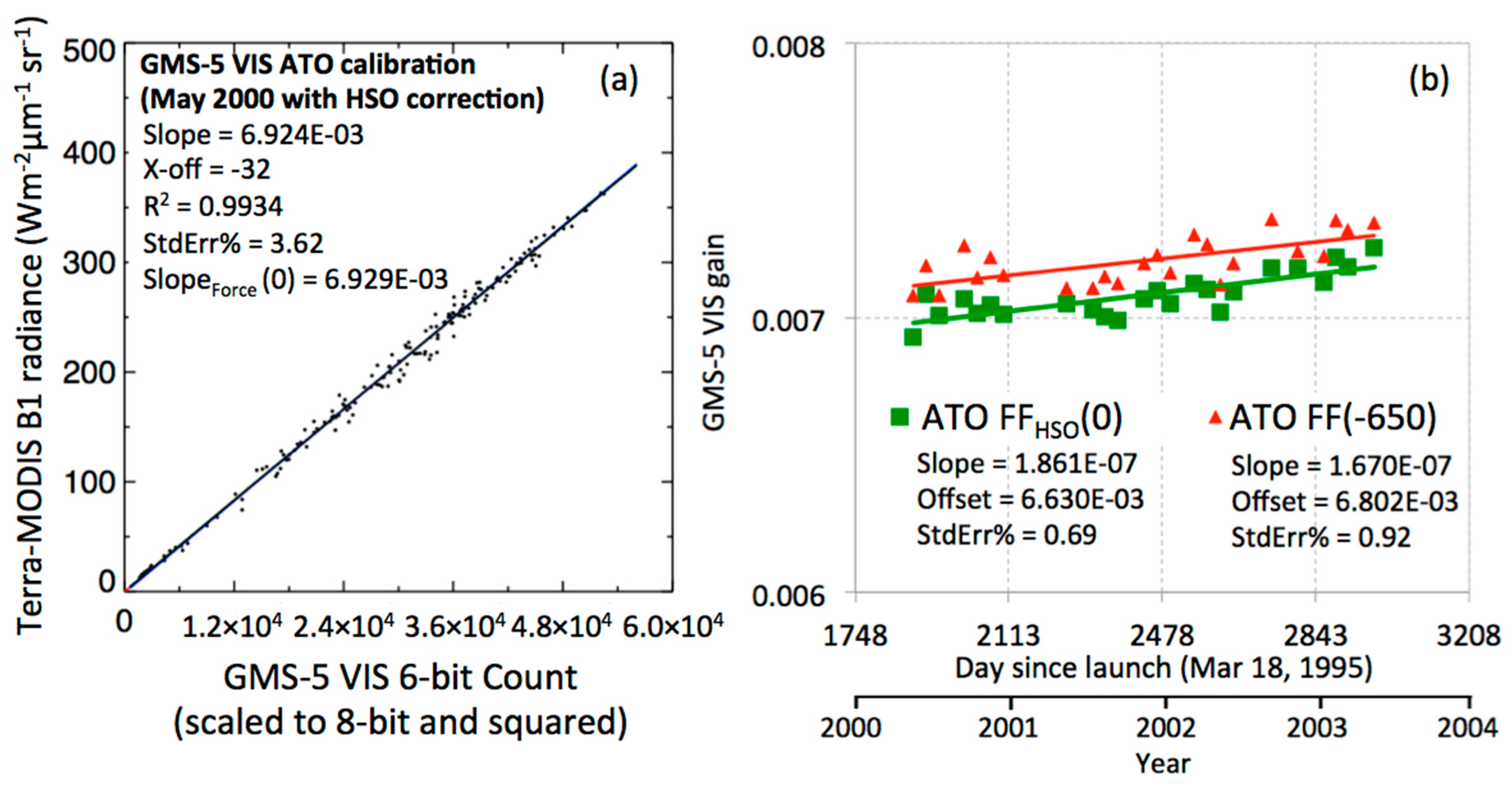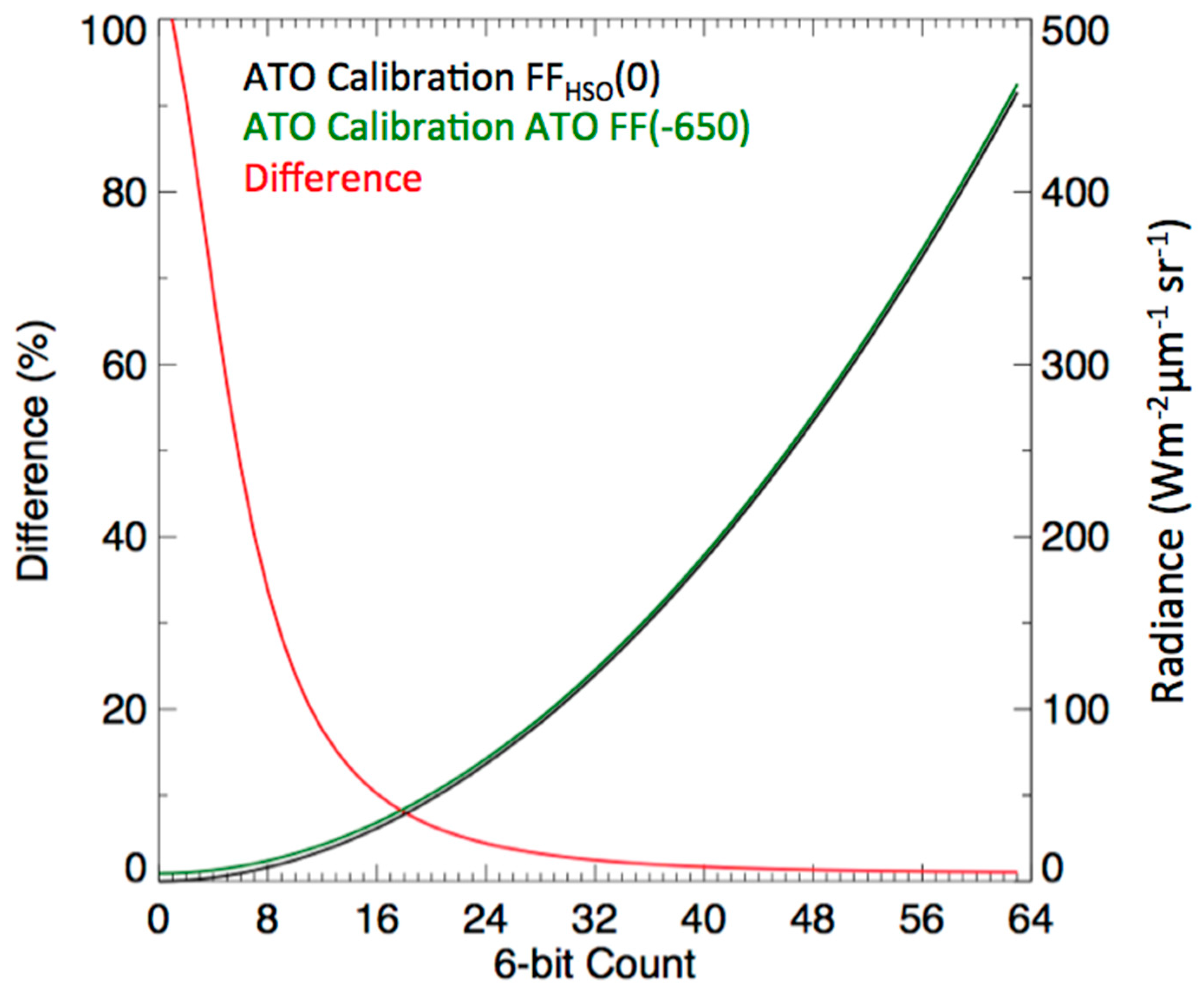Consideration of Radiometric Quantization Error in Satellite Sensor Cross-Calibration
Abstract
:1. Introduction
2. Methodology
2.1. GMS-5 Inter-Calibration with MODIS
2.2. GMS-5 Quantization Error Dependence on Radiance
2.3. Historical VISSR Calibration Efforts
2.4. Simulation Method
Count = Integer(√R/ADCres)
2.4.1. Linear Sensor Response
2.4.2. Squared Sensor Response
2.5. Half-Step Offset Correction
3. Results and Discussion
3.1. GMS-5 HSO Validation
3.2. GMS-5 and MTSAT-2 Comparison
3.2.1. Deep Convective Clouds
3.2.2. Badain Jaran Desert
4. Conclusions
Author Contributions
Acknowledgments
Conflicts of Interest
Glossary of Acronyms
| ADC | Analog-to-Digital Converter |
| ASDC | Atmospheric Science Data Center |
| ATO-RM | All-sky Tropical Ocean Ray Matching |
| AVHRR | Advanced Very High-Resolution Radiometer |
| BRDF | Bidirectional Reflectance Distribution Function |
| CERES | Clouds and Earth’s Radiant Energy System |
| DAAC | Distributed Active Archive Center |
| DCC | Deep Convective Clouds |
| FF | Force Fit |
| GAC | Global Area Coverage |
| GEO | Geostationary Earth Orbiting |
| GMS-5 | Geostationary Meteorological Satellite-5 |
| GSICS | Global Space-based Inter-Calibration System |
| HSO | Half-Step Offset |
| IR-BT | Infrared Brightness Temperature |
| ISCCP | International Satellite Cloud Climatology Project |
| JMA | Japanese Meteorological Agency |
| McIDAS | Man computer Interactive Data Access System |
| MODIS | Moderate Resolution Imaging Spectroradiometer |
| MTSAT-2 | Multifunction Transport Satellite-2 |
| NASA | National Aeronautics and Space Administration |
| NOAA | National Oceanic and Atmospheric Administration |
| NPP | National Polar-orbiting Partnership |
| Probability Distribution Function | |
| PICS | Pseudo-Invariant Calibration Site |
| QE | Quantization Error |
| ROI | Region of Interest |
| SBAF | Spectral Band Adjustment Factors |
| SC | Space Count |
| SCIAMACHY | SCanning Imaging Absorption spectrometer for Atmospheric CHartographY |
| SRF | Spectral Response Function |
| SZA | Solar Zenith Angle |
| TOA | Top of Atmosphere |
| TRMM | Tropical Rainfall Measuring Mission |
| TWP | Tropical Western Pacific |
| VIIRS | Visible Infrared Imaging Radiometer Suite |
| VIRS | Visible and Infrared Scanner |
| VISSR | Visible and Infrared Spin Scan Radiometer |
| VZA | Viewing Zenith Angle |
References
- Xiong, X.; Angal, A.; Butler, J.; Cao, C.; Doelling, D.R.; Wu, A.; Wu, X. Global Space-based Inter-Calibration System Reflective Solar Calibration Reference: From Aqua MODIS to S-NPP VIIRS. Proc. SPIE 2016, 9881. [Google Scholar] [CrossRef]
- Scarino, B.R.; Doelling, D.R.; Minnis, P.; Gopalan, A.; Chee, T.; Bhatt, R.; Lukashin, C.; Haney, C.O. A web-based tool for calculating spectral band difference adjustment factors derived from SCIAMACHY hyperspectral data. IEEE Trans. Geosci. Remote Sens. 2016, 54, 2529–2542. [Google Scholar] [CrossRef]
- Chander, G.; Hewison, T.J.; Fox, N.; Wu, X.; Xiong, X.; Blackwell, W.J. Overview of Intercalibration of Satellite Instruments. IEEE Trans. Geosci. Remote Sens. 2013, 51, 1056–1080. [Google Scholar] [CrossRef]
- Wielicki, B.A.; Barkstrom, B.R.; Harrison, E.F.; Lee, R.B., III; Smith, G.L.; Cooper, J.E. Clouds and the Earth’s Radiant Energy System (CERES): An Earth Observing System experiment. Bull. Am. Meteorol. Soc. 1996, 77, 853–868. [Google Scholar] [CrossRef]
- Doelling, D.R.; Loeb, N.G.; Keyes, D.F.; Nordeen, M.L.; Morstad, D.; Nguyen, C.; Wielicki, B.A.; Young, D.F.; Sun, M. Geostationary enhanced temporal interpolation for CERES flux products. J. Atmos. Ocean. Technol. 2013, 30, 1072–1090. [Google Scholar] [CrossRef]
- Doelling, D.R.; Haney, C.O.; Scarino, B.R.; Gopalan, A.; Bhatt, R. Improvements to the geostationary visible imager ray-matching calibration algorithm for CERES Edition 4. J. Atmos. Ocean. Technol. 2016, 33, 2679–2698. [Google Scholar] [CrossRef]
- Doelling, D.; Haney, C.; Bhatt, R.; Scarino, B.; Gopalan, A. Geostationary Visible Imager Calibration for the CERES SYN1deg Edition 4 Product. Remote Sens. 2018, 10, 288. [Google Scholar] [CrossRef]
- Uprety, S.; Cao, C. Suomi NPP VIIRS reflective solar band on-orbit radiometric stability and accuracy assessment using desert and Antarctica Dome C sites. Remote Sens. Environ. 2015, 166, 106–115. [Google Scholar] [CrossRef]
- Mishra, N.; Helder, D.; Angal, A.; Choi, J.; Xiong, X. Absolute Calibration of Optical Satellite Sensors Using Libya 4 Pseudo Invariant Calibration Site. Remote Sens. 2014, 6, 1327–1346. [Google Scholar] [CrossRef] [Green Version]
- Bhatt, R.; Doelling, D.R.; Morstad, D.; Scarino, B.R.; Gopalan, A. Desert-based absolute calibration of successive geostationary visible sensors using a daily exoatmospheric radiance model. IEEE Trans. Geosci. Remote Sens. 2014, 52, 3670–3682. [Google Scholar] [CrossRef]
- Bhatt, R.; Doelling, D.R.; Scarino, B.R.; Gopalan, A.; Haney, C.O.; Minnis, P.; Bedka, K.M. A consistent AVHRR visible calibration record based on multiple methods applicable for the NOAA degrading orbits, Part I: Methodology. J. Atmos. Ocean. Technol. 2016, 33, 2517–2534. [Google Scholar] [CrossRef]
- Doelling, D.R.; Morstad, D.L.; Bhatt, R.; Scarino, B. Algorithm Theoretical Basis Document (ATBD) for Deep Convective Cloud (DCC) Technique of Calibrating GEO Sensors with Aqua-MODIS for GSICS. GSICS, 2011. Available online: http://gsics.atmos.umd.edu/pub/Development/AtbdCentral/GSICS_ATBD_DCC_NASA_2011_09.pdf (accessed on 21 April 2018).
- Wielicki, B.A.; Doelling, D.R.; Young, D.F.; Loeb, N.G.; Garber, D.P.; MacDonnell, D.G. Climate quality broadband and narrowband solar reflected radiance calibration between sensors in orbit. In Proceedings of the IGARSS 2008 IEEE International Geoscience and Remote Sensing Symposium, Boston, MA, USA, 7–11 July 2008. [Google Scholar]
- The GMS User’s Guide. Available online: http://www.data.jma.go.jp/mscweb/en/operation/docs/GMS_Users_Guide_3rd_Edition_Rev1.pdf (accessed on 21 April 2018).
- Lazzara, M.A.; Benson, J.M.; Fox, R.J.; Laitsch, D.J.; Rueden, J.P.; Santek, D.A.; Wade, D.M.; Whittaker, T.M.; Young, J.T. The Man computer Interactive Data Access System: 25 years of interactive processing. Bull. Am. Meteorol. Soc. 1999, 80, 271–284. [Google Scholar] [CrossRef]
- Fraser, R.S.; Kaufman, Y.J. Calibration of satellite sensor after launch. Appl. Opt. 1986, 25, 1177–1185. [Google Scholar] [CrossRef] [PubMed]
- Frouin, R.; Gautier, C. Calibration of NOAA-7 AVHRR, GOES-5, and GOES-6 VISSR/VAS Solar Channels. Remote Sens. Environ. 1987, 22, 73–101. [Google Scholar] [CrossRef]
- Tokuno, M.; Itay, H.; Tsuchiya, K.; Kurihara, S. Calibration of VISSR on board GMS-5. Adv. Space Res. 1997, 19, 1297–1306. [Google Scholar] [CrossRef]
- Tsuchiya, K.; Tokuno, M.; Itay, H.; Sasaki, H. Calibration of GMS-VISSR, features of MOS-VTIR and Landsat MSS. Adv. Space Res. 1996, 17, 1–10. [Google Scholar] [CrossRef]
- Le Marshall, J.F.; Simpson, J.J.; Jin, Z. Satellite Calibration Using a Collocated Nadir Observation Technique: Theoretical Basis and Application to the GMS-5 Pathfinder Benchmark Period. IEEE Trans. Geosci. Remote Sens. 1999, 37, 499–507. [Google Scholar] [CrossRef]
- Minnis, P.; Smith, W.L., Jr.; Garber, D.P.; Ayers, J.K.; Doelling, D.R. Cloud Properties Derived from GOES-7 for the Spring 1994 ARM Intensive Observing Period Using Version 1.0.0 of the ARM Satellite Data Analysis Program. NASA Reference Publication 1366, August 1995. Available online: https://ntrs.nasa.gov/archive/nasa/casi.ntrs.nasa.gov/19960021096.pdf (accessed on 16 July 2018).
- Nguyen, L.; Minnis, P.; Ayers, J.K.; Doelling, D.R. Intercalibration of meteorological satellite imagers using VIRS, ATSR-2, and MODIS. In Proceedings of the AMS 11th Conference on Satellite Meteorology and Oceanography, Madison, Wisconsin, 12–16 October 2001; pp. 442–445. Available online: https://ntrs.nasa.gov/archive/nasa/casi.ntrs.nasa.gov/20020023392.pdf (accessed on 21 April 2018).
- Minnis, P.; Nguyen, L.; Doelling, D.R.; Young, D.F.; Miller, W.F.; Kratz, D.P. Rapid calibration of operational and research meteorological satellite imagers, Part I: Evaluation of research satellite visible channels as references. J. Atmos. Ocean. Technol. 2002, 19, 1233–1249. [Google Scholar] [CrossRef]
- Inamdar, A.K.; Knapp, K.R. Intercomparison of independent calibration techniques applied to the visible channel of the ISCCP B1 data. J. Atmos. Ocean. Technol. 2015, 32, 1225–1240. [Google Scholar] [CrossRef]
- Ignatov, A.; Cao, C.; Sullivan, J.; Levin, R.; Wu, X.; Galvin, R. The usefulness of in-flight measurements of space countto improve calibration of the AVHRR solar reflectance bands. J. Atmos. Ocean. Technol. 2005, 22, 180–200. [Google Scholar] [CrossRef]
- Doelling, D.R.; Bhatt, R.; Scarino, B.R.; Gopalan, A.; Haney, C.O.; Minnis, P.; Bedka, K.M. A consistent AVHRR visible calibration record based on multiple methods applicable for the NOAA degrading orbits, Part II: Validation. J. Atmos. Ocean. Technol. 2016, 33, 2517–2534. [Google Scholar] [CrossRef]
- NASA-Langley SCIAMACHY SBAF Tool. Available online: https://satcorps.larc.nasa.gov/SBAF (accessed on 21 April 2018).
- Doelling, D.R.; Morstad, D.L.; Scarino, B.R.; Bhatt, R.; Gopalan, A. The characterization of deep convective clouds as an invariant calibration target and as a visible calibration technique. IEEE Trans. Geosci. Remote Sens. 2013, 51, 1245–1254. [Google Scholar] [CrossRef]
- Hu, Y.B.; Wielicki, B.A.; Yang, P.; Stackhouse, P.W., Jr.; Lin, B.; Young, D.F. Application of deep convective cloud albedo observation to satellite-based study of the terrestrial atmosphere: Monitoring the stability of spaceborne measurements and assessing absorption anomaly. IEEE Trans. Geosci. Remote Sens. 2004, 42, 2594–2599. [Google Scholar]
- Bhatt, R.; Doelling, D.R.; Scarino, B.; Haney, C.; Gopalan, A. Development of Seasonal BRDF Models to Extend the Use of Deep Convective Clouds as Invariant Targets for Satellite SWIR-Band Calibration. Remote Sens. 2017, 9, 1061. [Google Scholar] [CrossRef]
- Zhang, Y.; Zhong, B.; Liu, Q.; Li, H.; Sun, L. BRDF of Badain Jaran Desert retrieval using Landsat TM/ETM+ and ASTER GDEM data. In Proceedings of the IEEE International Geoscience and Remote Sensing Symposium (IGARSS), Vancouver, BC, Canada, 24–29 July 2011; pp. 1818–1821. [Google Scholar]
- Wang, Z.; Barlage, M.; Zeng, X.; Dickinson, R.; Schaaf, C. The solar zenith angle dependence of desert albedo. Geophys. Res. Lett. 2005, 32. [Google Scholar] [CrossRef]
- Roujean, J.L.; Leroy, M.J.; Deschamps, P.Y. A bidirectional reflectance model of the Earth’s surface for the correction of remote sensing data. J. Geophys. Res. 1992, 97, 20455–20468. [Google Scholar] [CrossRef]











© 2018 by the authors. Licensee MDPI, Basel, Switzerland. This article is an open access article distributed under the terms and conditions of the Creative Commons Attribution (CC BY) license (http://creativecommons.org/licenses/by/4.0/).
Share and Cite
Bhatt, R.; Doelling, D.; Haney, C.; Scarino, B.; Gopalan, A. Consideration of Radiometric Quantization Error in Satellite Sensor Cross-Calibration. Remote Sens. 2018, 10, 1131. https://doi.org/10.3390/rs10071131
Bhatt R, Doelling D, Haney C, Scarino B, Gopalan A. Consideration of Radiometric Quantization Error in Satellite Sensor Cross-Calibration. Remote Sensing. 2018; 10(7):1131. https://doi.org/10.3390/rs10071131
Chicago/Turabian StyleBhatt, Rajendra, David Doelling, Conor Haney, Benjamin Scarino, and Arun Gopalan. 2018. "Consideration of Radiometric Quantization Error in Satellite Sensor Cross-Calibration" Remote Sensing 10, no. 7: 1131. https://doi.org/10.3390/rs10071131




